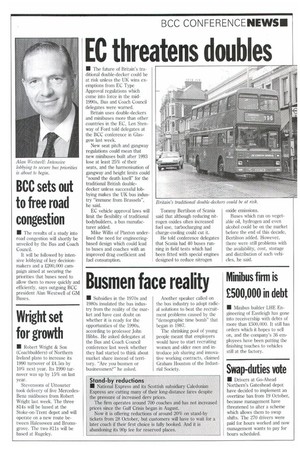EC threatens doubles
Page 19

If you've noticed an error in this article please click here to report it so we can fix it.
• The future of Britain's traditional double-decker could be at risk unless the UK wins exemptions from EC Type Approval regulations which come into force in the mid1990s, Bus and Coach Council delegates were warned.
Britain uses double-deckers and minibuses more than other countries in the EC, Len Stenway of Ford told delegates at the BCC conference in Glasgow last week.
New seat pitch and gangway regulations could mean that new minibuses built after 1993 lose at least 25% of their seats, and the harmonisation of gangway and height limits could "sound the death knell" for the traditional British doubledecker unless successful lobbying makes the UK bus industry "immune from Brussels", he said.
EC vehicle approval laws will limit the flexibility of traditional bodybuilders, a bus manufacturer added.
Mike Willis of Plaxton underlined the need for engineeringbased design which could lead to buses and coaches with an improved drag coefficient and fuel consumption. Tommy Berti'son of Scania said that although reducing nitrogen oxides often increased fuel use, turbocharging and charge-cooling could cut it.
He told conference delegates that Scania had 40 buses running in field tests which had been fitted with special engines designed to reduce nitrogen oxide emissions.
Buses which run on vegetable oil, hydrogen and even alcohol could be on the market before the end of this decade, Beni!son added. However, there were still problems with the availability, cost, storage and distribution of such vehicles, he said.
















































































































